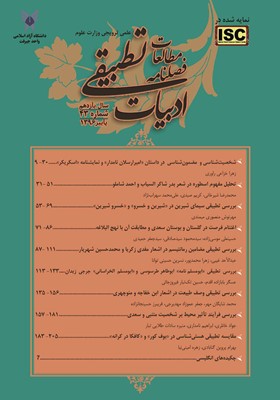شخصیتشناسی و مضمونشناسی در داستان «امیرارسلان نامدار» و نمایشنامه «اسکریکر»
محورهای موضوعی : شعر
1 - عضو هیأت علمی گروه زبانهای خارجی، دانشکده ادبیات و علوم انسانی، دانشگاه شهید باهنر کرمان، کرمان، ایران (استادیار).
کلید واژه:
چکیده مقاله :
مطالعه حاضر به بررسی تطبیقی مفاهیم شخصیتشناسی و مضمونشناسی در داستان امیرارسلان نامدار اثر محمدعلی نقیب الممالک، نویسنده ایرانی قرن نوزدهم و اسکریکر اثر کریل چرچیل، نمایشنامهنویس انگلیسی قرن بیستم اختصاص یافته است. پژوهشگران با استفاده از روش کیفی و تحلیل محتوا، ابتدا به بررسی نوع ادبی هر کدام از آثار ادبی پرداخته و سپس شخصیتهای اسطورهای، مضمونشناسی ادبی و در نهایت مفاهیم فرهنگ عامه را در دو اثر مورد بررسی تطبیقی قرار داده است. نتیجه این تحلیلها نشان میدهدکه شخصیتهای دو اثر از لحاظ تبدیلشوندگی، خردمندی و زودباوری در دو فرهنگ عامه مجزا قابل تطبیق هستند. بنمایهها، درونمایهها و تصاویر نیز از دیگر موارد قابل انطباق محسوب میشوند.
The present paper studies the impressions of character and concepts reading in "Amir Arsalan Namdar" by Mohammad Ali Naqib-al-Mamalek – Iranian author of nineteenth century – and "The Skriker" by Caryl Churchill – the English play writer of twentieth century comparatively. The researchers initially analyze the literature type by enjoying qualitative method and content analysis and then considers the mythical characters. Literary concept reading and the public culture finally and comparatively. The results of the analyses show that the characters of both works are comparable from wisdom, gullibility and changeability point of view in different cultures. Motives, themes and images also are known as comparable ones.


